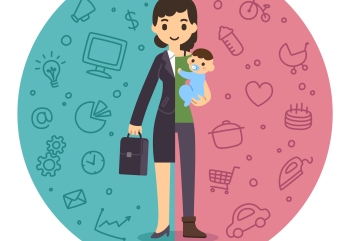
.png) Aarti
Aarti

The reported recent decision of the Sikkim Government to enhance the maternity leave of its female employees from 6 months to 12 months and also provide paternity leave (one month) is laudable.
With this generous benefit, Sikkim may be able to improve its population, which is currently the lowest in India at around 6.32 lakh.
The average number of children born to women of childbearing age in a given population, most commonly known as the Total Fertility Rate (TFR), varies worldwide.
According to latest reports, South Korea has the lowest TFR at 0.78 and the highest is 6.73 in Niger, a country in West Africa, where most of its land area lies in the Sahara Desert.
In India, compared to the global average TFR of 2.3 children, as per the fifth round of National Family Health Survey (NFHS) conducted during 2019-21 (released last August) it is 2.0 (down from 2.2 as per NFHS-4 (2015-16) and 2.85 as per NFHS-2 (1988-89).
Sikkim’s TFR has drastically fallen to 1.1 (NFHS-5) from 1.2 (NFHS-4) and 2.8 (NFHS-2).
The birth of a child undoubtedly brings joy and excitement. However, to protect the employment of women during the time of her maternity, the Union Government enacted the Maternity Benefit Act in 1961. It entitles working women engaged in mines, the circus industry, plantations and shops or establishments employing 10 or more persons (except those who are covered under the Employees’ State Insurance) of maternity benefit – i.e., full paid absence from work – to take care of her child up to 12 weeks due to delivery. In cases of illness arising due to pregnancy, etc., they are entitled to additional leave with wages for a period of one month and six weeks with wages in case of miscarriage.
Based on recommendations from various quarters, when the Act was amended in 2017, the maternity benefit was raised from 12 weeks to 26 weeks for working women with two surviving children and 12 weeks for more than two children. An adopting mother (one who legally adopts a child below the age of three months) including a commissioning mother (one who commissions a surrogate mother to bear a child on her behalf), can avail maternity benefit for a period of twelve weeks from the date the child is handed over to the adopting mother or the commissioning mother, as the case may be.
In case where the nature of work assigned to a woman is such that she may work from home, the employer is to allow her to do so after availing of the maternity benefit for such period and on such conditions as the employer and the woman may mutually agree. Further every establishment with 50 or more employees has to provide the facility of creche within such distance as may be prescribed, either separately or along with common facilities. The woman employee is permitted to visit the creche four times a day, which also includes the interval for rest allowed to her.
Most of the States in India, in line with the Central Act, have enacted their own Maternity Benefit Act. In March last year, Tamil Nadu notified amendments to its Maternity Benefit Act wherein it has raised the maternity leave from 9 months (270 days) to 12 months (365 days).
27 percent of women in the Indian workforce according to a 2018 study join work, about 48 percent drop out within four months of returning from maternity leave and 50 percent drop out mid-career before the age of 30 for childcare.
In industrialised countries like the US, the Family and Medical Leave Act provides protection for parents to take away time from their job following childbirth. Even as no national paid parental-leave policy exists, some progressive organisations do provide paid parental leave. However, the cause for concern is the gender bias. A recent study found that men were not penalised for becoming a father and were being offered higher salaries than their childless counterparts. Whereas, women experience a reduction in compensation and the impacts are greatest when children are youngest (under 5 years of age). Typically, mothers are less likely to be called back for jobs, recommended for hire or recommended for promotion. More so because employers view mothers as unreliable due to the distraction of family responsibilities. Employers were found to rate mothers’ competency 10 percent lower than non-mothers and similarly, mothers’ commitment to their jobs was 12 percent lower.
Well, for a new born, the first six months are quite crucial according to the World health Organisation and UNICEF. Children should be breastfed within the first hour of birth which must be continued for the first 6 months of life – meaning no other foods or liquids are to be given to the child, including water.
Breastfeeding, which provides optimal nutrition to the child and prevents infection as well as malnutrition, has been found to cut down 22 percent of all neonatal deaths. Breast milk, not only has a protective effect against childhood obesity but is also an important source of energy and nutrients. It can provide half or more of a child’s energy needs between the ages of 6 and 12 months and one-third of energy needs between 12 and 24 months.
The maternity leave is of immense help to new mothers as infants need to be breastfed on demand – that is as often as the child wants, day and night. However, many infants reportedly do not receive optimal feeding and only about 44 percent of infants aged 0–6 months worldwide were exclusively breastfed over the period of 2015-2020. For mothers, longer durations of breastfeeding has been found to contribute to their health and well-being. Besides reducing the risk of ovarian and breast cancers, helping space pregnancies, breastfeeding also promotes postpartum weight loss of lactating mothers.
Various surveys have shown that a large number of working mothers most often feel low on energy. While some do not get proper sleep, others are burdened with health issues after childbirth. Many new mothers seem to suffer from postpartum depression which includes anxiety, confusion, irritability etc. As a number of factors increase a new mother’s vulnerability to avoidable health issues, at the workplace there is an imperative need to have them examined minutely so as to find lasting solutions.
Well, that e-commerce giant Amazon has reportedly put in efforts to retain working mothers in India inspires confidence. It is said that among others, multiple options are being offered to them like virtual and flexible working opportunities. Post their 26 weeks of paid maternity leave, women employees can have a modified work schedule for up to 8 weeks.
Air India, which has around 5,000 women employees, that includes flying and non-flying staff, has been in the news for providing 26 weeks of maternity leave to its women employees as well as daycare support under its revamped policies. Notably, women pilots are to be given the choice to opt for quicker turnaround flights till the child reaches the age of one year. There will also be counselling sessions to address mental well-being, preparation for childbirth and plans to return to work for expectant mothers.
Regulatory authorities need to regularly conduct surprise checks and wherever the rules merely exist on paper, such organisations need to swiftly brought to book.
Looking beyond rules and regulations, treating women as equal partners can go the extra mile in smashing the gender bias.